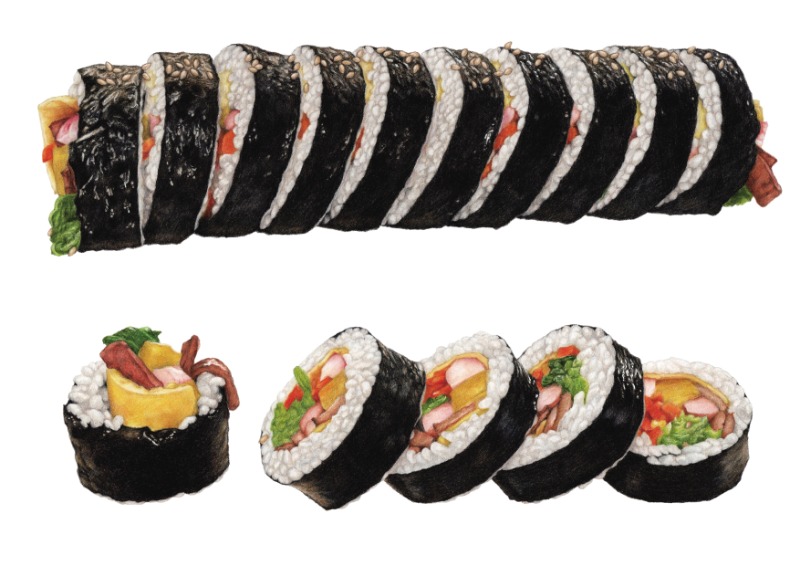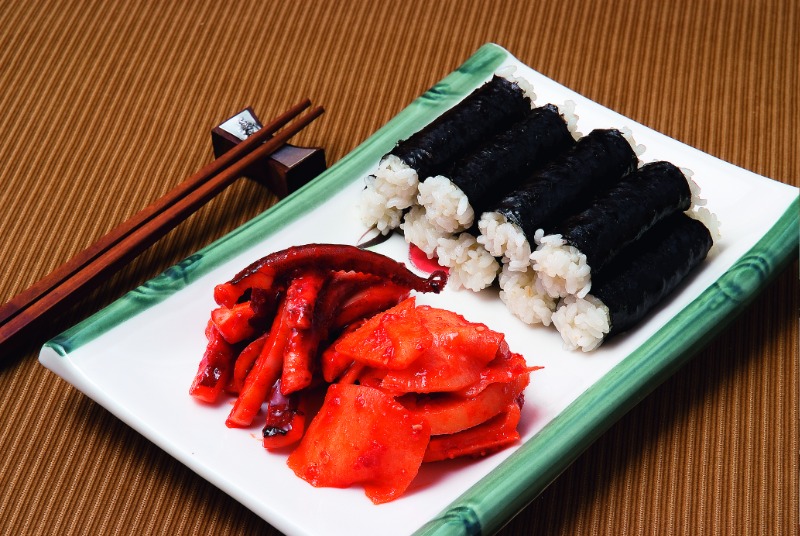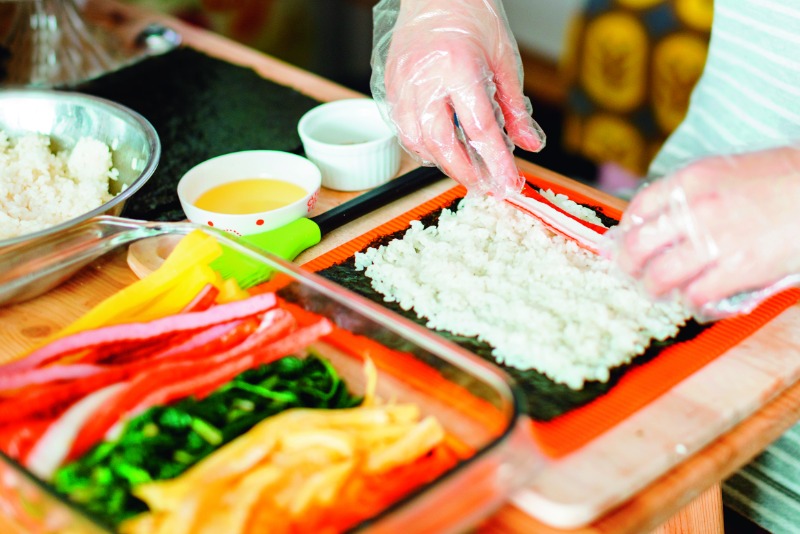Gimbap, a roll of rice packed with vegetables, meat and various other ingredients wrapped in a sheet of laver (dried seaweed), is a popular light meal that is nutritious while also evoking pleasant memories of childhood.

The humble gimbap evokes fond memories thanks to countless combinations of ingredients and seasonings used by Korean mothers. Lately, gimbap has moved up the culinary ladder to “premium” variations featuring unusual ingredients.
There are a variety of traditional foods with a history and story unique to Koreans, but few foods have captured people’s hearts as much as gimbap.
Koreans grow up accustomated to the taste of their mother’s unique version of gimbap: indeed, a common boast is “my mother’s gimbap is the best.” On taste alone, a case can be made for gimbap made with spinach seasoned with sesame oil and soy sauce, burdock root and fish cake stir-fried in soy sauce, various vegetables, and rice seasoned with a dash of sesame oil and salt. Entirely different combinations, however, are also possible. Of course, unmatched are individual memories of where, when and with whom a mother’s gimbap was enjoyed.
UNCERTAIN ORIGIN
The exact origin of gimbap (gim meaning dried seaweed, or laver, and bap meaning cooked rice) is unknown. While some argue that it originated from Japanese norimaki – a roll of rice, raw fish, cucumber, dried gourd strips, and pickled radish tightly wrapped in a sheet of laver – others argue that gimbap is a version of bokssam, which was eaten during the latter half of the Joseon Dynasty (1392–1910).
The origin of the name “gimbap” itself is also uncertain. A recipe for “chobap,” in the March 29, 1958 edition of the Dong-A Ilbo, seems to describe gimbap made with rice flavored with vinegar, or cho. The recipe calls for wrapping various ingredients, such as fish, mushrooms, bean curd, spinach, and carrot, in a sheet of laver covered with cooked rice flavored with 2/3 of a cup of vinegar, 2 tablespoons of sugar, 1 tablespoon of salt, and 1 tablespoon of monosodium glutamate (MSG). In later gimbap recipes, the vinegar was left out.
However, Koreans began eating cooked rice wrapped in laver long before gimbap appeared in the modern era. “A Record of Seasonal Customs in Korea” (Dongguk sesigi), published in 1849, mentions both gimssam and bokssam, which refer to rice and various side dishes eaten together, wrapped in a sheet of laver or leafy greens. A late 18th century cookbook titled Siuijeonseo mentions people eating laver brushed with oil and sprinkled with salt. Many assume that rice would have been wrapped in the laver.
The first Korean records of gim itself go back even further. Two 15th-century texts, “Geography of Gyeongsang Province” (Gyeongsangdo jiriji) and “Geography of Korea” (Dongguk yeoji seungnam), mention gim as a local product of Gyeongsang Province and Jeolla Province, respectively, suggesting that people’s diet at the time contained seaweed.
Whatever the origin of gimbap, the farming of gim is believed to be native to Korea. According to a story that dates back some 300 years, an old woman in Hadong, South Gyeongsang Province, was collecting shellfish in the Seomjin River when she picked up a piece of driftwood covered in seaweed. Her subsequent practice of attaching seaweed to bamboo poles, which she placed in the sea, is thought to be the start of seaweed cultivation in Korea.
CHUNGMU GIMBAP

Fishermen in the seaside city of Tongyeong (formerly named Chungmu) needed food that would not spoil quickly when they were out at sea. That led to Chungmu gimbap, consisting of plain rice rolls with radish kimchi and seasoned baby octopus on the side. It became a signature Korean food after 1950.
© gettyimagesKOREA
A completely Korean version of gimbap gradually evolved after 1950. In the early stages, before raw fish was widely included in the Korean diet, vegetables and other common household ingredients were prominent in the wrapped rice roll. The amount of vinegar was reduced to satisfy local tastes, and the rice was seasoned only with sesame oil and salt or, occasionally, sesame salt only to bring out its natural flavor.
Kim Yun-yeol, whose mother sold gimbap in Daegu’s Dalseong-dong district in the late 1940s, recalled: “My mother seasoned the rice with a little vinegar, sugar, and sesame oil, and sold it as ‘gimchobap.’ In today’s terms, it tasted similar to Japanese makisushi. When my mother reopened a gimbap shop after the Korean War, she removed the vinegar and mixed the rice with sugar, salt, and sesame oil. She also took out the red-dyed Japanese pickles and added carrots, pickled radish, and eggs.”
Chungmu gimbap, a local food of Tongyeong, South Gyeongsang Province, is an indispensable part of any discussion of gimbap. “Chungmu” was the former name of the seaside city of Tongyeong. The theory is that Chungmu gimbap started when a fisherman ate radish kimchi and seasoned baby octopus with plain rice wrapped in laver. Neither the rice nor the laver were seasoned to reduce the possibility of spoilage during long periods at sea. Instead, the plain rice rolls were eaten with sweet and sour radish kimchi and seasoned baby octopus on the side. As Chungmu gimbap became popular, households made their own versions, using sliced radish instead of radish kimchi or squid or fish cake with spicy sauce instead of seasoned baby octopus.
GREATER SOPHISTICATION

The most common type of gimbap is made of rice seasoned with sesame oil and salt, then rolled up with pickled radish, egg rolls, carrots, burdock root, ham and spinach.
© Shutterstock
Gimbap of the 21st century has now shed any Japanese associations and is generally understood as a Korean food. The most common form of gimbap today is made of rice seasoned with sesame oil and salt, which is spread over a sheet of dried laver and topped with strips of pickled radish, fried egg, carrot, burdock root, ham, spinach, and cucumber before being rolled up. Of course, this is a general guideline only, with ingredients differing by household, depending on the family’s tastes and what is in the refrigerator. Gimbap is synon-ymous with lunch boxes and picnics prepared by mothers with their intuitive understanding of the family’s tastes. People joke that there are as many different flavors of gimbap as there are mothers across Korea.
NO LIMITS FOR GIMBAP
The commercialization of gimbap began in Incheon when Gimbap Cheonguk (literally “gimbap heaven”) opened in 1995 and became a national franchise within five years. At that time, its “1,000-won gimbap” was inexpensive but generously filled with ingredients, making it a convenient and nutritious breakfast for office workers in a hurry. It was also around that time that gimbap became firmly established as a restaurant menu item.
Since then, many variations of gimbap have appeared. The “premium gimbap” craze gripped the Korean market for some time, offering consumers diverse ingredients such as spicy stir-fried pork, bulgogi, pork cutlet, fried anchovies, canned tuna and mayonnaise, fried shrimp and seasoned shredded squid. Some gimbap restaurants include chicken breast or other protein-rich ingredients.
With an increasing number of vegans and health-seeking people who avoid meat, gimbap stuffed with seasoned vegetables such as thistle (gondre namul) or radish greens, pickled vegetables and carrots have been introduced.
A close look at some of the old local gimbap restaurants that have gained national fame through word of mouth reveals vast regional differences. Oseonmo Yennal Gimbap in Jeonju, North Jeolla Province, is popular for its carrot-filled version; at Gyori Gimbap in Gyeongju, North Gyeongsang Province, the favorite is egg kimbap, in which fried egg strips account for 90 percent of the ingredients. Similarly, Owolui Gimbap (literally “gimbap of May”) at Nakseongdae Station in Seoul sells an outsized roll that also consists of more than 90 percent fried egg strips. Dongwon Bunsik in Busan is a gimbap restaurant off the tourist track. Filled with thick sliced eggroll (dalgyalmari) and spicy shredded squid (thin strips of semi-dried squid stir-fried in gochujang sauce), the gimbap here is a delicacy. On Jeju Island, there are places that sell gimbap with a whole saury in it. Regardless of its rather bizarre appearance, the savory taste of brown grilled saury goes nicely with the rice. Gimbap filled with pork belly, a beloved Korean barbeque meat, is also popular.
Gimbap is the ultimate Korean comfort food and is expected to keep evolving thanks to the endless possible combinations of increasingly diverse ingredients. Domestic food critics and experts are convinced that gimbap will soon, as a category of “K-food,” join the ranks of Korean cultural exports. Exposure of gimbap in dramas such as the smash-hit “Extraordinary Attorney Woo” is also creating greater awareness of this dish overseas. Perhaps gimbap will join Mexican tortillas, American hot dogs, Italian pizza, German bratwurst and other global favorites.